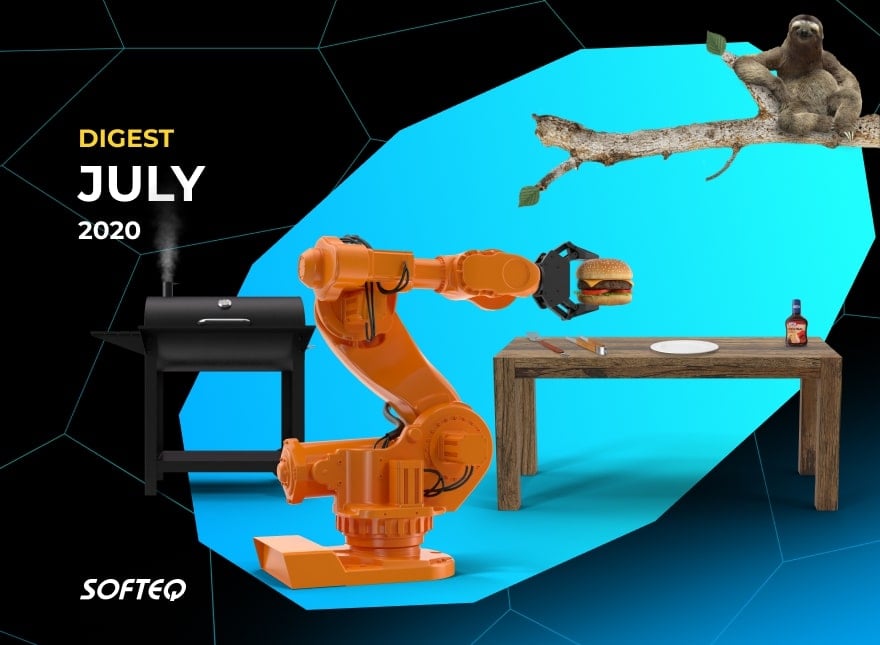Check out our latest blog article: From component to enterprise – modular robotics done right.
This is What Techies Talked about in July

In this issue of the Tech Digest: IoT platforms bring unnecessary complexity to the emerging market, hand-drawn tattoos are on track to replace wearables, and robotic sloths help scientists collect data in the wild. All that and more in a 10-minute read.
The evolution of the IoT value chain: where does your business fit in?
With a quarter of businesses using connected devices in their day-to-day operations, the core principles of organizing an IoT vendor’s economic activities are beginning to change. According to a recent report issued by Boston Consulting Group (BCG), the linear path that runs from component manufacturers to OEMs and end customers is a thing of the past. Today, companies that aggregate data from their products or their clients’ business processes have the upper hand. These companies can set up industry-specific IoT cloud platforms, and other vendors will contribute their services, data, and products to the ecosystem. The report raises an important issue though: the tech companies that decide not to participate in the emerging IoT business models will become mere suppliers of commodity hardware. Wienke Giezeman, the initiator of The Things Network group that transformed Amsterdam into a smart city in just six weeks, echoes the sentiment. Mr. Giezeman argues that platforms will introduce unnecessary complexity to the market, as company-wide IoT solutions often require low-level customization. To help newcomers navigate the shifting market, IoT Analytics prepared a detailed report that highlights IoT pioneers’ journey from zero to hero.
Machine Learning in the enterprise: where will the value accrue?
In a post-pandemic world, the concept of Digital Transformation no longer centers on aggregating company data in ERP systems. Instead, IT departments feed the data to custom Machine Learning models to automate enterprise workflows. Another category of companies profiting off of Machine Learning includes cloud platform providers, who take the stress out of algorithm training and deployment. And some companies are turning to Machine Learning to disrupt entire industries—think self-driving vehicles and precision farming. In her recent article for Forbes, Louisa Xu identifies the biggest opportunities for Machine Learning within the enterprise sector.
Robots on a roll: fancy trying a burger made by a robotic chef?
July has been an exciting time for both robotics enthusiasts and companies looking to augment the human workforce with smart machines. For years, robotic arms have been created in the image and likeness of human limbs. The devices contained a combination of actuated joints and long straight tubes, and the only way to increase their versatility was to add more components to the structure. Earlier this month, the researchers from REDS Lab (Imperial College London) unveiled a new robotic arm design concept. The team swapped rigid tubes for layers of polyester sheets, which can move smoothly against one another and let human operators adjust the shape of the robotic arm. Another example comes from White Castle. The restaurant chain created a cooking robot in collaboration with Miso Robotics. Named Flippy, the robot can move swiftly between workstations to fry potatoes and flip burgers and thus allows kitchen staff to focus on getting food to delivery drivers. But speed and flexibility do not always equal efficiency. Inspired by the sloths he met in Costa Rica, Magnus Egerstedt from Georgia Tech created SlothBot—an energy-saving robot that collects data in the wild and recharges itself using solar panels. The ability to identify and grasp transparent and reflective objects is another breakthrough in robotics. The researchers from Carnegie Mellon University are using special color cameras to train robots to pick up objects with a glossy or reflective surface. Considering these advances in Artificial Intelligence and hardware design, it is safe to say that dynamic, fully flexible, and efficient robots will soon take over fastidious and fast-paced jobs—on the factory floor, at warehouses, and even in the operating theater.
Shape-shifting wearables: is it time to replace your Fitbit with a pencil-drawn tattoo?
In his recent article for CNET, Richard Nieva details Google’s quest for the ultimate wearable device. Since the early 2010s, the tech giant has been quietly funding or directly developing a plethora of wearable technology projects, including the infamous Google Glass, smartwatches, and fabric-woven sensors. A solution that stands out from the rest, though, is the 2017 prototype called SkinMarks. Essentially, it is a smart tattoo that transforms a person’s skin into a touchpad. The tattoo is loaded with sensors, which can be activated by squeezing your skin or bending your limbs if the mark is applied close to your joints. At the time, the researchers from Saarland University argued that human skin could be the most natural form of a wearable device. Three years later, the University of Missouri team discovered that pencil lead, which contains at least 93% graphite, could pick up electric signals from human skin, including body temperature, heart rate, and glucose levels. This means we can potentially replace high-end wearable devices with hand-drawn temporary tattoos while using biocompatible adhesive to fix the graphite particles. The beauty of this concept lies in its simplicity: such sensors can be applied quickly and require commonplace and inexpensive materials.
Augmented Reality’s big moment: should your company jump on the AR bandwagon?
Despite billions of dollars poured into Virtual Reality startups, the technology may never break into the mainstream. Augmented Reality, on the other hand, does not always require expensive hardware and can be used in a variety of settings, including classrooms and brick-and-mortar stores. And now there’s proof AR is driving sales, too. A year ago, Google introduced 3D Swirl Ads, which allow users to rotate and zoom in on 3D objects in online ads. According to Chris Seahorn, SVP of Marketing and Merchandising for eBags, the new ads format helped the company increase conversions by 112% on mobile devices and by 81% on PCs. eBags’ success will surely prompt more brands to investigate the opportunities Augmented Reality creates for their business. To help company leaders navigate the AR landscape, Kimberly A. Whitler of Forbes hand-picked five articles that shed light on the technology’s turbulent past and optimistic future.
